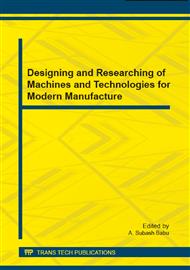[1]
Liu H., et al. Size effect in insect flight: leading-edge vortex, trailing-edge vortex and tip vortex. Journal of Biomechanics 39 (2006): S356-S357.
DOI: 10.1016/s0021-9290(06)84425-8
Google Scholar
[2]
Wang Hao, et al. Measuring wing kinematics, flight trajectory and body attitude during forward flight and turning maneuvers in dragonflies. Journal of Experimental Biology 206. 4 (2003): 745-757.
DOI: 10.1242/jeb.00183
Google Scholar
[3]
Norberg, R. Åke. The pterostigma of insect wings an inertial regulator of wing pitch. Journal of comparative physiology 81. 1 (1972): 9-22.
DOI: 10.1007/bf00693547
Google Scholar
[4]
Young, John, et al. Details of insect wing design and deformation enhance aerodynamic function and flight efficiency. Science 325. 5947 (2009): 1549-1552.
DOI: 10.1126/science.1175928
Google Scholar
[5]
Thomas, Adrian LR, and Graham K. Taylor. Animal flight dynamics I. Stability in gliding flight. Journal of Theoretical Biology 212. 3 (2001): 399-424.
DOI: 10.1006/jtbi.2001.2387
Google Scholar
[6]
Sun M., and J. K. Wang. Dynamic flight stability and control of a hovering hoverfly. Journal of Biomechanics 39 (2006): S357.
DOI: 10.1016/s0021-9290(06)84427-1
Google Scholar
[7]
Sun Mao, Jikang Wang, and Yan Xiong. Dynamic flight stability of hovering insects. Acta Mechanica Sinica 23. 3 (2007): 231-246.
DOI: 10.1007/s10409-007-0068-3
Google Scholar
[8]
Thomas, Adrian LR, et al. Dragonfly flight: free-flight and tethered flow visualizations reveal a diverse array of unsteady lift-generating mechanisms, controlled primarily via angle of attack. Journal of Experimental Biology 207. 24 (2004).
DOI: 10.1242/jeb.01262
Google Scholar
[9]
Dickinson, Michael H., Fritz-Olaf Lehmann, and K. G. Gotz. The active control of wing rotation by Drosophila. Journal of experimental biology 182. 1 (1993): 173-189.
DOI: 10.1242/jeb.182.1.173
Google Scholar
[10]
Sunada, Shigeru, Lijiang Zeng, and Keiji Kawachi. The relationship between dragonfly wing structure and torsional deformation. Journal of Theoretical Biology 193. 1 (1998): 39-45.
DOI: 10.1006/jtbi.1998.0678
Google Scholar
[11]
Wang, Jikang, and Mao Sun. A computational study of the aerodynamics and forewing-hindwing interaction of a model dragonfly in forward flight. Journal of experimental biology 208. 19 (2005): 3785-3804.
DOI: 10.1242/jeb.01852
Google Scholar
[12]
Wang, Z. Jane, and David Russell. Effect of forewing and hindwing interactions on aerodynamic forces and power in hovering dragonfly flight. Physical review letters 99. 14 (2007): 148101.
DOI: 10.1103/physrevlett.99.148101
Google Scholar
[13]
Usherwood, James R., and Fritz-Olaf Lehmann. Phasing of dragonfly wings can improve aerodynamic efficiency by removing swirl. Journal of the Royal Society Interface 5. 28 (2008): 1303-1307.
DOI: 10.1098/rsif.2008.0124
Google Scholar
[14]
Wakeling, J. M., and C. P. Ellington. Dragonfly flight. II. Velocities, accelerations and kinematics of flapping flight. Journal of experimental biology 200. 3 (1997): 557-582.
DOI: 10.1242/jeb.200.3.557
Google Scholar
[15]
Gai Kuo. Wing Damage Effect on Dragonfly's Aerodynamic Performance during Takeoff. Diss. Wright State University, (2013).
Google Scholar
[16]
Sudo, Seiichi, et al. Wing Morphology and Powered Flight of Insects. Journal of Aero Aqua Bio-mechanisms 1. 1 (2010): 24-29.
DOI: 10.5226/jabmech.1.24
Google Scholar



